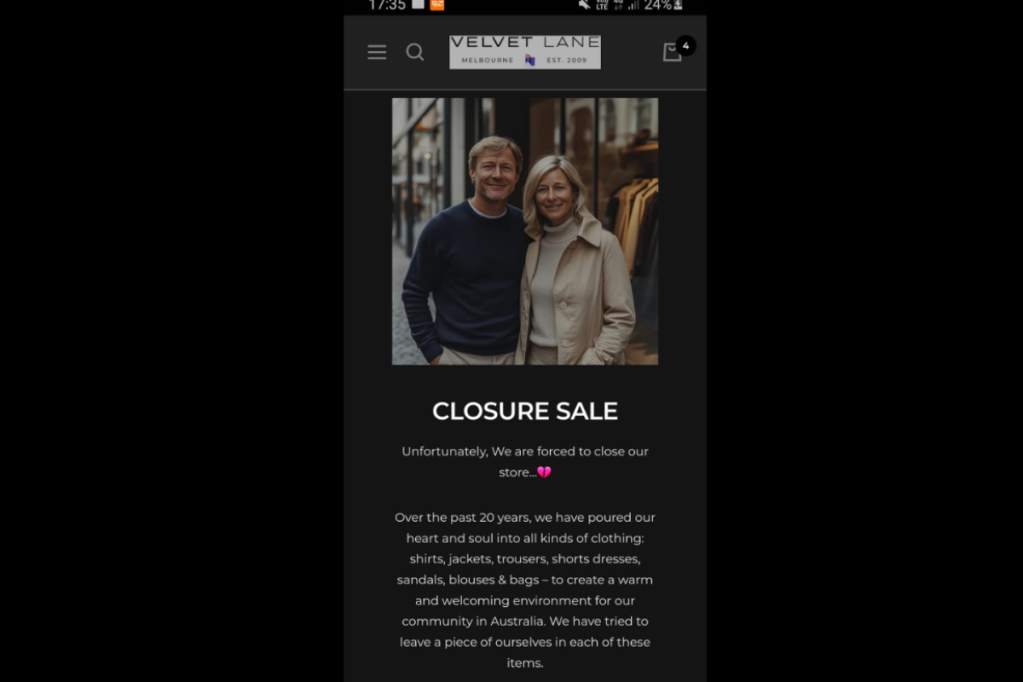They pretend to be local boutiques with massive sales – but these ghost stores are scams. Here’s how to spot them.
It’s easy to get swept up in the excitement of snagging a great deal during sales – but scammers are counting on that rush.
Right now, there’s a particularly sneaky new trick in town that’s fooling even seasoned bargain hunters: ghost stores. Prevalent on social media – particularly TikTok – here’s everything you need to know to spot this scam so you can shop safely.

What is a ghost store?
Ever scrolled past a video for a charming local boutique you’ve never heard of, offering huge discounts because they’re “closing down”? With a heartfelt backstory and tempting deals, it seems like the ideal chance to buy something for less – but there’s a catch.
You’ve probably just stumbled on a “ghost store”.
Ghost stores are sophisticated scams disguised as genuine bricks-and-mortar or online boutiques. They hook you in with emotional claims of struggling against rising rents and tough competition, coupled with heartfelt thanks to their loyal customers.
To convince you they’re genuine, scammers use carefully crafted emotional narratives, AI-generated images of owners looking proudly at their “store”, and familiar Aussie locations like Byron Bay, Barossa, or Bondi.
In reality, these shops never existed. They’re usually operated by scammers based overseas, with zero local connection or physical presence.

Three red flags that scream “ghost store”
- Sketchy or missing contact details: Legit stores proudly display their location, phone number, and email. Good luck finding an actual address or speaking to a real person if it’s a ghost store!
- Brand-new websites: Ghost stores usually appear suddenly, just days before big sales events (think EOFY sales, mid-season offers or Christmas bargains) and vanish quickly after grabbing your cash.
- Copy-and-paste vibes: Identical product descriptions, emotional stories, or suspiciously similar images across different websites are all huge warning signs.
If you’re unlucky enough to buy from one, you’ll probably receive nothing – or at best, cheap and disappointing knockoffs shipped from who knows where.
But wait, there’s more! Other ways scammers might target you
Ghost stores might be the new headline-grabber, but the SA Police warn scammers have plenty more tricks up their sleeves during sales.
Scams involving fake retail websites can mimic trusted brands so convincingly that even savvy shoppers can fall victim.
Then there are scammers impersonating legitimate retailers through carefully crafted ads that pop up on your socials, hoping to lure you into clicking through to dodgy sites.
Deceptive pricing, fake promotions, and counterfeit goods are also common pitfalls – promising unbeatable deals but delivering only disappointment or nothing at all.
All these scams have one goal in mind: getting hold of your cash, personal information, or both.

Scam-proof your sales shopping in five steps
But here’s the good news – you don’t have to skip the sales to stay safe. Just follow these quick tips to outsmart the scammers:
- Check the ABN: Legit Australian businesses have an Australian Business Number. Quickly verify it at ABN Lookup.
- Independent reviews matter: If the only glowing reviews you find are on the store’s website, think twice. Check independent review sites instead.
- Look twice at the URL: Fake sites mimic real ones – You should see https in the browser and carefully check the spelling and domain names are accurate.
- Get to a site your own way: Want to make doubly sure the website you’re using is the right one? Navigate directly to it via your web browser, not via a link provided in a text message, email or social media ad.
- Use secure payments only: It’s safer to pay by credit cards, PayPal, or similar secure options. Steer clear of wire/bank transfers, gift cards, or cryptocurrency payments.
- Trust your gut: If something feels off, slow down and investigate further.

What scammers are costing us
Australians lost more than $4.8 million to online shopping scams in 2024, with 16,272 cases reported to Scamwatch.
2025 is shaping up to be just as costly – scammers have already swiped a reported $2.5 million from Australians in just the first four months.
Currently, around one in three scams go unreported, so the real cost is even higher.
And it’s not just Boomers falling for these scams. The total losses by shoppers aged under 45 were actually higher than those aged over 45 last year.
It’s Millennials (those aged 35-44) who were hit hardest, experiencing the highest losses and reporting the greatest number of incidents of any age group.

Help! I’ve been scammed – now what?
Don’t panic, act fast:
- Immediately contact your bank to block further payments and seek a charge back.
- If your personal details are compromised, seek guidance from IDCare.
- If you have suffered harm or a financial loss, make a report at www.cyber.gov.au or attend your local Police Station.
- To make a report of an experience where no harm or loss has occurred and to access some excellent resources, visit the Scamwatch website.
If you have found yourself a victim of a scam, watch out for follow up attempts as scammers often come for more. Unfortunately, 1 in 3 victims of a scam have been scammed more than once.
Remember, every report you make helps authorities track down scammers faster and protect others from falling into the same trap.
So even if you feel a bit embarrassed or the amount lost wasn’t huge, it’s worth the few minutes it takes to make a report online.
For more tips and advice to shop smart and stay safe, click here.

















